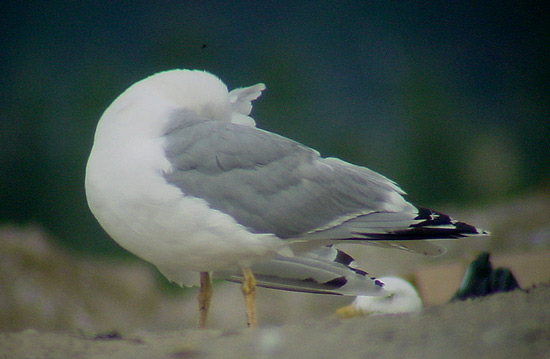 Herring
Gull - Zilvermeeuw (argentatus & argenteus)
Herring
Gull - Zilvermeeuw (argentatus & argenteus)
(last update: 08 december 2003)
Home
Links
to Gull Sites
Gull Taxa
Gull Topography
Grey & Colour Charts
Locations in NW Europe
Summaries of Articles
About ORG
@
Herring Gull adult (argentatus), August 06 2002, Tampere, Finland (61.31N,23.43E).
An adult argentatus, with a combination of features which can probably only be found in Scandinavia: yellow legs and a complete thayeri pattern on both P9 and P10. This bird has a coral red orbital ring. The outer primaries P6-P10 are still old, with a complete sub-terminal band on P6. Primary P4 is fully grown. Note the rather pale grey upper-parts. Note the pattern on the underside of P10, where the white mirror merges with the tip, without any sign of a sub-terminal band and the medial band not reaching to the inner-web's edge, thus creating a thayeri pattern.
This pattern is named after the Thayer's Gull, which often shows a particular pattern in the outer primaries: the mirror and the white tip merge and are connected to the pale inner-web. In other words: the black medial band of the outer-web doesn't fully reach the edge of the inner-web and there is no sub-terminal band. In Thayer's Gull this pattern may be very obvious and, together with the 'string of pearls' may be indicative for identification. A string of pearls refer to the white crescents, which can be found between the sub-terminal band and the grey patch on the inner-web. In the picture below, these white crescents are lacking. Note the "irregular" pattern of the division line between the black outer-web and the grey tongue.
This individual is in active complete moult with the outer median coverts replaced and the upper tertials, inner lower lesser and central median coverts shed. Note the relatively pale grey upper-parts, as can be found in argentatus from the southern Baltic region.
From June to December, adult argentatus
undergo a complete moult resulting in so-called "winter
plumage". By August, the first
neat streaks can be found on the crown and hind-neck. After the complete moult is
finished by late autumn, the head will show extensive 'winter streaking', often
neat fine streaking in sub-adult argentatus.
By the end of the complete moult (sometimes mid-January in argentatus), the scapulars, mantle,
all the wing-coverts, rectrices and remiges will be replaced. From June onwards, the new plain grey wing-coverts are
moulted in, starting with the outermost median coverts.
During the summer, the primaries are moulted. In adult argentatus, the last outer primary P10 will be fully grown by January (but also early December in southern populations?), a few weeks later than in West-European argenteus. First data from Tampere, Finland, indicate that 3cy argentatus from this region are not delayed in primary moult compared to argenteus.
Adult northern argentatus show a different
pattern in the outer primaries, compared to argenteus. In
argentatus, especially from northern Scandinavia, the black marking
on P5 is very limited and, if black on P5 is present, this black has
diffuse edges. But often, these black sub-terminal markings are completely
lacking on P5. In Baltic argentatus populations, black on P5 is confined
to the outer-web, with sharply defined edges.
Argenteus normally has a black sub-terminal band on the top of p10,
dividing the tip from the mirror. If the black sub-terminal band on P10 is
broken, the outer-web of p10 still shows black marking. Argentatus
normally completely lacks sub-terminal markings, also on the outer-web of
P10. Some argentatus completely lack black on the edge of the
inner-web, creating a so-called "thayeri pattern".
The iris is clearly yellow in summer in most argentatus, but some sub-adult argentatus will keep the iris amber to dark brown.
